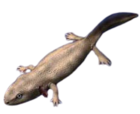| Urupia Temporal range: | |
|---|---|
| Scientific classification | |
| Domain: | Eukaryota |
| Kingdom: | Animalia |
| Phylum: | Chordata |
| Class: | Amphibia |
| Order: | Urodela |
| Genus: | † Urupia Skutschas & Krasnolutskii, 2011 |
| Type species | |
| †Urupia monstrosa Skutschas & Krasnolutskii, 2011 | |
Urupia is an extinct genus of salamander in what is now Russia from the Bathonian aged Itat Formation. It was described by P. P. Skutschas and S. A. Krasnolutskii in 2011, and the type species is U. monstrosa. [1]




